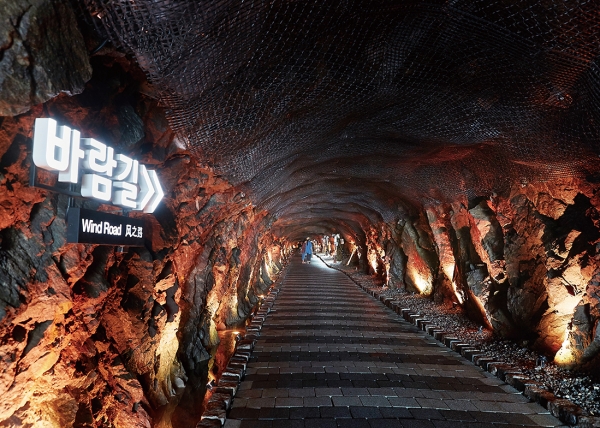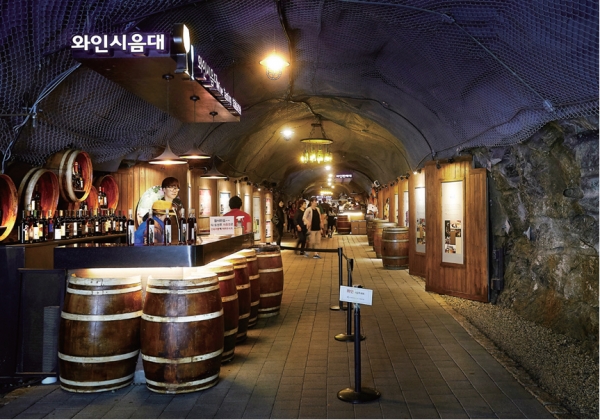
Gwangmyeong-donggul Cave was once a gold mine whose workers were exploited by the Japanese colonial government. In 1912, the cave was mined for gold, silver, copper and iron mostly by peasants who were either avoiding forced labor or just trying to survive. The sheer size of the cave and its painting residue are evidence of the miners’ hardship.
Until flooding and pollution led to its closure in 1972, the cave continued to be mined for gold for 60 years. Hundreds of kilograms of the precious metal were found here from 1912-54. After its closure, the cave was used to store pickled shrimp delivered from Sorae Port.
When the Gwangmyeong city government in 2011 purchased the cave to redevelop it, a full-scale transformation ensued. The cave’s surroundings were revamped as a theme park featuring over 20 entertainment facilities such as Cave Arts Center, Wine Cave, Golden Palace, Golden Waterfall, Cave Aqua World, Cave Greenhouse, Underground Lake, Modern History Museum and VR (Virtual Reality) Center.
The cave offers more than just entertainment as a regenerated space of cultural creativity and an industrial relic from the eras of Japanese imperialism and Korea’s modernization. The cave was named one of the “Stars of Korean Tourism in 2017” and “100 Destinations for Korean Visitors for 2017-20” by the Ministry of Culture, Sports and Tourism and the Korea Tourism Organization. Attracting over a million visitors every year, the cave is now a gold mine for cultural arts and heritage.

Gwangmyeong-donggul Cave retains a mild temperature of 12-13 degrees Celsius throughout the year.
The exploration of the cave starts with Wormhole Square, which opens a divergent road. On the walls is LED lighting shaped like marine organisms. Follow the bright fish straight into the cave to find a large square the size of a field and Korea’s one and only Cave Arts Center. Decked out with seating for 350 people, the center plays a CGI-enabled media facade on the domeshaped cave wall every 20 minutes. Lasting ten minutes, the show features flamboyant primary colors as an impressive experience in new media arts against the backdrop of natural darkness. Occasional performances by orchestras, fashion shows and cultural exhibitions are also held.

Proceed through the corridor that gold miners passed through for excavation in the past to reach the secretive area of Aisha, the blacksmith fairy. Her imaginary habitat is a six-pillar golden palace where gold is produced and stocked in a gold room. Visitors throw coins into the golden vault to wish for their own wealth and post their written desires on the Golden Plaque Wall of Wishes on the Golden Road.

Moving further underground leads to a realm of greater mystery. One level down is a pool of aquifer water that sparkles in turquoise hues with an eye-catching aqua tint. This fresh, top-grade aquifer supplies World of Water in the cave and the sustenance for its marine life and flora. Fish from near and far are spotted at World of Water, among which golden fish dubbed “golden dragons” are especially popular. Contrary to the cave seeming to be uninhabitable, greenery and marine life more than thrive there.
The deepest corners of the cave house a giant dragon dubbed “king of the cave.” At 41 meters long and weighing 800 kg, it is the largest figure in Korea. Weta Workshop of New Zealand, famed for producing the blockbusters “The Lord of the Rings” and “King Kong,” manufactured 30 portions of the dragon that were sent to Korea via air delivery.
A life-size figure of the villain Gollum is huddled in front of the dragon, as if in fear. The limited edition figure from Weta is displayed alongside the wand that the wizard Gandalf used in the “Rings” films.
Fine Wine


Capping off a tour of Gwangmyeongdonggul Cave is the Wine Cave. Since Gwangmyeong does not produce wine, the Wine Cave’s presence might seem irrelevant. Far less recognized than foreign wine, Korean wine has struggled to generate publicity or secure distribution channels.
To help domestic wine manufacturers overcome this hurdle, the city government assembled 200 kinds of wine sourced from 49 wineries nationwide, the biggest stash of its kind in the country. Since 2015, the Korea Wine Festival is hosted every year to promote Korean wine. The consistently mild temperatures of Gwangmyeong-donggul Cave make it ideal for wine storage, and this has made the venue a national mecca for domestic wine.
The entrance to the Wine Cave allows free sampling of Korean wine. Sour, sweet and aromatic scents resonate upon tasting. Unlike foreign wines made of grapes, the Korean versions utilize an assortment of domestic fruits such as mulberry, loquat, persimmon, peach, kiwi and apples. The sheer variety of ingredients attest to the wide variety of tastes Korean wines offer. Wine sampling also leads to more purchases, as Gwangmyeong-donggul Cave boasts the highest volume of wine sales in the nation.

About 100 meters from the entrance of Gwangmyeong-donggul Cave is the VR Center, which offers a Gwangmyeongdonggul Cave-themed and lifelike experience using VR glasses. Exploration of the underground cave is done on a tram-like vehicle for 12 people that allows a virtual journey to the subterranean realm. Using just a joystick controller, passengers can install dynamite to mine minerals like a miner, see Gwangmyeong’s eight signature sites and climb Nodu Stone, where mine development originated.
The Lascaux International Exhibition, designed by acclaimed modern architecture specialist Jean Nouvel, ran at Gwangmyeong-donggul Cave in 2016. Sporting the nation’s largest beam projection video system, the venue hosts media art performances, promotional events and conferences as a global convergence site for compound arts. The events held here include “Lascaux Paleolithic Cave Paintings: Gwangmyeong Cave,” “Globally Renowned Arts Through Media Art,” “Barbie Dolls Exhibition,” “Dinosaur Experiential Exhibition” and “Rainbow Factory: A Playground of Lights.”
Written by Kim Hye Young
Photographed by Stuido Kenn
Source: http://www.kocis.go.kr


